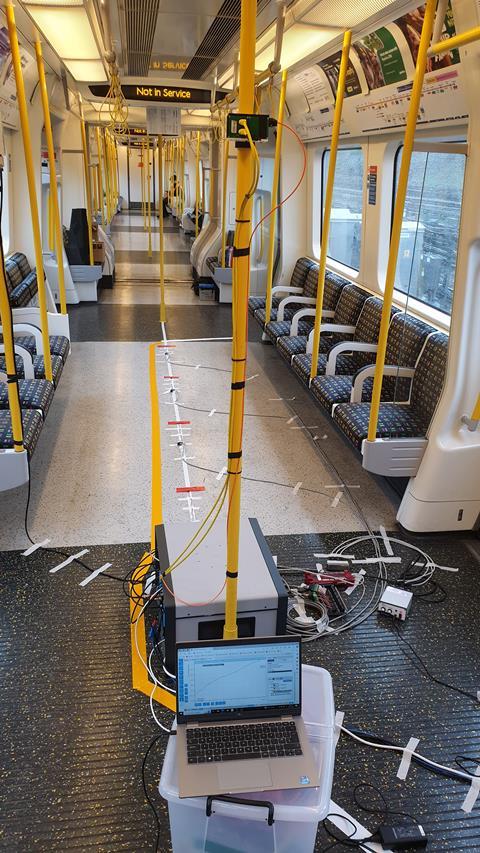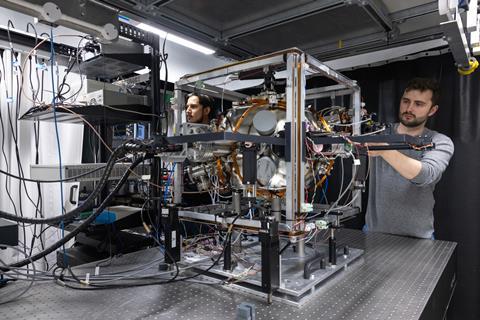
UK: Researchers are using a London Underground train to test whether quantum inertial navigation systems could be used to provide accurate location information for condition-based monitoring, train control and signalling applications without needing satellites or lineside equipment.

This forms part of a wider programme to develop an alternative to global navigation satellite systems which would be able to work underground, would not be degraded in the shadow of buildings and cannot be compromised by hostile action.
‘There has been lots of fundamental physics work over a decade’, Clive Roberts, Professor of Railway Systems Engineering at the University of Birmingham, told Metro Report International. He is the founder of the university’s spinout company MoniRail Ltd, which will lead the project. ‘The technology is now getting to the point where there are real sensors which can be tried in all sorts of applications.’
Current train location systems use both satellite-based systems as well as inertial sensors and gyroscopes to assess how far a train has moved and work out where it is in three-dimensional space. Roberts said the aim is to ‘take this to the next level’ by replacing the sensors with quantum systems.
Satellite systems can provide locations to around 1 m, or better with more advanced technology, but they suffer from drift and accuracy is significantly reduced with poor reception. Quantum systems are expected to achieve 10 cm or better, without any drift.
Research partners

The project brings together a range of research and industrial partners to ‘kick the tyres on the technology’ and ‘get an early understanding of what is feasible in a railway environment’, Roberts explained.
This includes a team from Imperial College London who specialise in using atom interferometry to make highly accurate inertial sensors and accelerometers.
Physicists from the University of Sussex are developing magnetic field sensors which use laser light to manipulate the quantum properties of materials and infer the strength and direction of the earth’s magnetic field, which can be compared against mapped data to identify a train’s location.
Researchers at the University of Birmingham are providing rail systems engineering expertise and will lead testing and assessment.
MoniRail brings experience of using inertial sensors and GPS for rail infrastructure condition monitoring.
PA Consulting has expertise in quantum-technologies and technology development, while defence technology company QinetiQ is providing positioning and navigation experience.
The trials will be used to help development of a commercialisation roadmap, and Unipart is looking at how the technology could be manufactured commercially. Roberts estimates that a commercial product could be available on a five- to 10-year horizon.
Funding is being provided by the Department for Science, Innovation & Technology, and Innovate UK.
London Underground trials

The equipment is being tested on an out-of-service passenger train, running on London Underground’s District, Circle and Hammersmith & City lines.
’The idea is to understand these sensors better, how they work and behave and then iteratively improve them’, said MoniRail CEO Peter Ainsworth.
Roberts said, ‘I’d be amazed if we turn it on and it just works — that’s not the nature of research!’
The partners see rail as an ideal environment for testing. It offers relatively harsh conditions, with vibration and a complex electromagnetic environment, and sensors suitable for rail use would be able to work in other applications.
Roberts said the equipment is currently ‘somewhere between a fridge-freezer and a shoebox’ in size, and while it will get smaller as it is further developed, this is a scale suitable for on-train use. Trials have been undertaken at sea, ‘but going out on boats is quite difficult’, says Ainsworth. ‘Trains are a bit easier.’
While the technology is not cheap, the price point could be a good fit for rail as it removes the need to install lineside equipment such as balises and the expense and difficulty of sending people out to maintain it.
Until now the focus of research in the quantum navigation field has been on military applications, and according to Roberts ‘rail could be one of the early civil applications of quantum technology, which makes it really quite exciting’.














